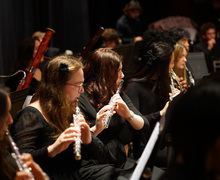Colvin: ‘Jessica Jones’ paves way for comic book female empowerment
In an industry where leaders have failed to offer well-rounded representations of women in mainstream media, Marvel is ahead of the curve.
Marvel’s “Jessica Jones,” set to premiere on Netflix later this year, is yet another addition to an increasingly diverse Marvel cinematic universe. The show has not even come out yet and it is still stirring up excitement. Hollywood is already buzzing about “Jessica Jones” as one of the most anticipated shows of this coming season and diehard comic fans have leaked alleged episode titles on Reddit.
This projected success, in addition to the positive reception of the new Marvel television series “Agent Carter,” whose protagonist is a woman, should prove to Hollywood executives and fandom naysayers that female superheroes can hold their own with the boys.
The title character of “Jessica Jones,” played by Krysten Ritter, is a retired superhero who takes up detective work in New York City. Jones is described as a tough and gritty protagonist – an anti-hero, if you will.
The fact that Jessica Jones is getting her own show on Netflix is progressive because Marvel tends to favor male superheroes when it comes to live-action adaptations of their comics. The longest-running example of this gendered tug-of-war is the mystery surrounding whether or not Black Widow will finally get her own movie.
While no studio has any obligation to follow the whims of their fans, it is curious that out of approximately 50 live-action Marvel movies, only one focuses primarily on a woman: Elektra, starring Jennifer Garner, which came out over 10 years ago.
This gap makes Jones’ leap from page to screen even more noteworthy because her character will be fully explored in a full season – which is much more than can be said about most other Marvel female characters.
It is true that Marvel has put some really cool superheroines on the big screen. Storm, Rogue, The Phoenix and Mystique practically run the X-Men. The Invisible Woman, Pepper Potts, Dr. Jane Foster, Lady Sif, Darcy Lewis, Gamora, Scarlet Witch, and Emma Stone’s Gwen Stacy are each smart, clever, loveable and dangerous in their own way.
However, all of these fantastic female characters have appeared in minimized roles next to their male counterparts. The presence of these women was not meaningless, but their screen time was limited. Additionally, while romance is never a bad thing, it’s interesting to note how much of that narrow representation is used up on entertaining sexual tension as opposed to saving the world or complex character development.
While Jones’ story in particular is not for kids, having a formidable and multifaceted character like Jones benefits female Marvel fans of all ages. Jones will contribute to the push from women who produce and consume comic books for more empowering representations of their gender.
This push led to the reintroduction by Marvel of the Norse god Thor as Lady Thor, and Ms. Marvel as a practicing Muslim teenager named Kamala Khan, not the former blonde-haired, blue-eyed Carol Danvers. But while these advancements are noteworthy, there is more room for improvement when it comes to creating and maintaining a gender-inclusive brand.
The demand for more superheroines is not setting a fandom up for a battle of the sexes. It’s more simple than that: there’s nothing wrong with male superheroes, but it is empowering for women and girls to have favorites that look like them, and to let them know that they have the capacity to be badass, too.
Caroline Colvin is a sophomore magazine journalism major. Her column appears weekly. She can be reached at ccolvin@syr.edu and followed on Twitter at @fkacaro.
Published on September 10, 2015 at 12:30 am






